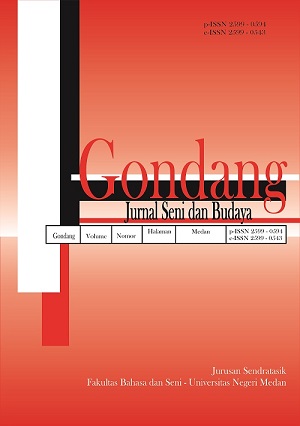Kelas Gitar Akustik Berbasis Pembelajaran Kooperatif
DOI:
https://doi.org/10.24114/gondang.v4i2.18676Keywords:
Cooperative Learning, Acoustic Guitar, Study Group.Abstract
This article examines learning acoustic guitar in formal schools employing cooperative learning design. The problem is focused on students™ perceptions of the difficulty of interpreting theory, teacher mastery of music theory, and the learning methods used. This study aims to describe the cooperative learning method implemented in acoustic guitar classes at schools (N = 30). Data were collected through observation, interviews, and documentation to be analyzed qualitatively using an interactive model (Miles et al., 2014). The guitar learning process is carried out in groups by breaking the home group and the expert group. Music material in group interaction is in the form of theory and practice. Based on observations of students™ musical abilities, there is an increase in knowledge of music theory and practice in guitar classes. Students receive the highest score on the aspects of sound accuracy, chord progression to the song, and the time expended learning the song. This study concludes that learning acoustic guitar applying cooperative learning methods is effective in enhancing students™ musical understanding through appreciation and creation. Appreciative attitude turns out as a manifestation of a positive response affective.References
Banks, J. A., & Banks, C. A. M. (Eds.). (2016). Multicultural Education: Issues and Perspectives (9th ed.). John Wiley & Sons, Inc.
Cangro, R. M., & Cangro, R. (2013). Effects of Cooperative Learning Strategies on the Music Achievement of Beginning Instrumentalists. International Journal of Arts and Commerce, 2(7), 133“141.
Cayari, C. (2018). Connecting music education and virtual performance practices from YouTube. Music Education Research, 20(3), 360“376. Retrieved from https://doi.org/10.1080/14613808.2017.1383374
Chania, M. (2020). Persepsi siswa terhadap pembelajaran seni musik di kelas xi ipa 4 sma negeri 12 Padang. Jurnal Sendratasik, 8(3), 72“79.
Elpus, K., & Abril, C. R. (2011). High school music ensemble students in the United States: A demographic profile. Journal of Research in Music Education, 59(2), 128“145. Retrieved from https://doi.org/10.1177/0022429411405207
Hannafin, M. J., Hill, J. R., Land, S. M., & Lee, E. (2014). Student-Centered, Open Learning Environments: Research, Theory, and Practice. In J. M. Spector, M. D. Merrill, J. Elen, & M. J. Bishop (Eds.), Handbook of Research on Educational Communications and Technology (pp. 641“651). New York, NY: Springer New York. Retrieved 11 March 2020 from https://doi.org/10.1007/978-1-4614-3185-5_51
Hidayatullah, R. (2019). Kelas daring: Metode pembelajaran Gitar Tunggal Lampung. In Viyanti, I. Rakhmawati, R. Anggreini, & A. H. Saputri (Eds.), Prosiding Seminar Nasional Pendidikan Fakultas Keguruan dan Ilmu Pendidikan œTransformasi Pendidikan Abad 21 Menuju Society 5.0 (pp. 606“613). Bandar Lampung: FKIP Unila. Retrieved from http://semnaspend.fkip.unila.ac.id/2019/08/14/prosid/
Hidayatullah, R. (2020). Kreativitas dalam pendidikan musik. Musikolastika: Jurnal Pertunjukan Dan Pendidikan Musik, 2(1), 1“7. Retrieved from https://doi.org/doi: 10.24036/musikolastika.v2i1.32
Miles, M. B., Huberman, A. M., & Saldaña, J. (2014). Qualitative data analysis: A methods sourcebook (Third edition). Thousand Oaks, Califorinia: SAGE Publications, Inc.
Moleong, L. J. (2017). Metodologi penelitian kualitatif (36th ed.). Bandung: PT. Remaja Rodakarya.
Pusparini, D. (2016). Analisis peran guru dalam pembelajaran seni musik di Sekolah Dasar sekbin III Kecamatan Brebes Kabupaten Brebes (Skripsi). Universitas Negeri Semarang, Semarang.
Renshaw, P. (2013). Collaborative learning: A catalyst for organizational development in higher music education “ Postlude. In H. Gaunt & H. Westerlund (Eds.), Collaborative learning in higher music education (pp. 237“246). Farnham: Ashgate.
Sembiring, A. S., & Widiastuti, U. (2018). Analisis bahan ajar instrumen gitar persiapan program studi pendidikan musik Universitas Negeri Medan. Gondang: Jurnal Seni dan Budaya, 2(1), 1“8. Retrieved from https://doi.org/10.24114/gondang.v2i1.9761
Triyanto. (2017). Spirit ideologis pendidikan seni. Semarang: Cipta Prima Nusantara Semarang.
Utomo, U. (2013). Analisis kebutuhan guru seni musik dalam konteks pelaksanaan pembelajaran berbasis action learning di sekolah. Harmonia: Journal Of Arts Research And Education, 13(2), 110“119. Retrieved from https://doi.org/10.15294/harmonia.v13i2.2777
Published
How to Cite
Issue
Section
License
Copyright (c) 2020 Gondang: Jurnal Seni dan Budaya

This work is licensed under a Creative Commons Attribution 4.0 International License.

This work is licensed under a Creative Commons Attribution-NonCommercial-ShareAlike 4.0 International License.

